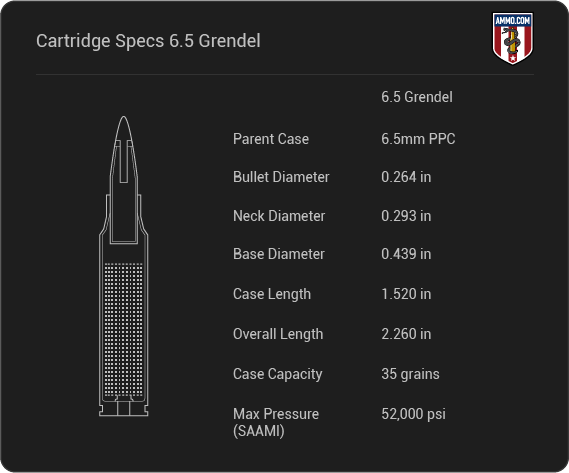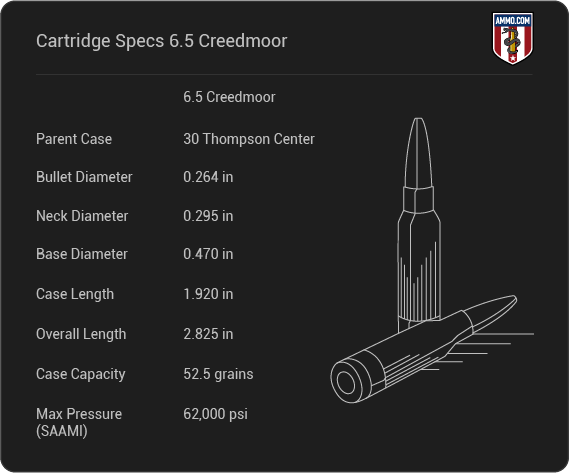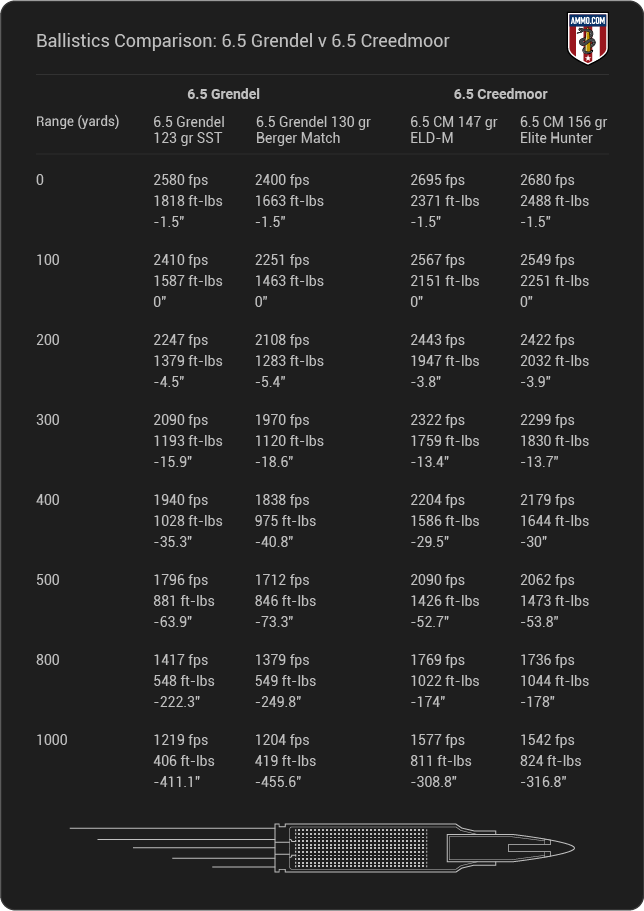Although it took Americans a little while to admit it, European hunters have known for years that 6.5mm projectiles are some of the most aerodynamic and accurate rounds for long-range shooting.
Two such rifle cartridges to burst onto the North American shooting scene are the 6.5 Creedmoor and the 6.5 Grendel.
Although both rounds fire the same 0.264” bullet diameter, they are vastly different in their application as the 6.5 Grendel was designed for the AR-15 while the 6.5 Creedmoor was developed with long range shooting competitions in mind.
Each round is excellent for target shooting and hunting medium game, but deciding which one is best for you depends mostly on what you want your rifle to do.
In this article we will examine the differences between these two 6.5mm all-star rifle cartridges and help you determine which round is best for your intended purpose.
The primary difference between the 6.5 Grendel and 6.5 Creedmoor is the rifles they were designed for. The 6.5 Grendel was designed to be fired from the AR-15 platform to enhance the lethality of the rifle while the 6.5 Creedmoor was designed to be fired from bolt-action rifles for long-range shooting competitions.
When evaluating centerfire cartridges, it’s a good idea to analyze the cartridge specs to gain more knowledge of each.
The 6.5 Creedmoor was released in 2007 and became extremely popular in long range competitive shooting circles. The Creedmoor was developed in part due to a gripe session between legendary Service Rifle competitor, Dennis DeMille, and Dave Emary, the senior ballistician for Hornady Ammunition at the National Matches in Camp Perry.

The 6.5 Creedmoor was developed by necking down a 30 Thompson Center case to accept a 6.5mm or 0.264” diameter bullet and was initially developed for long range shooting competitions.
The 6.5 Creedmoor is also called the 6.5 CM, 6.5 Creed, or can be misspelled as “Creedmore”.
In contrast, the 6.5 Grendel was released in 2003 as a new chambering for the AR-15 rifle and was designed to outperform the 5.56 NATO/223 Remington. Developed by Bill Alexander of Alexander Arms who also brought us the 50 Beowulf, the 6.5 Grendel descended from the 6.5mm PPC case which itself came from the 220 Russian, the parent case for the 7.62x39 Soviet round.
Although the 6.5 Creedmoor and 6.5 Grendel fire the same 0.264” diameter bullets, but they are drastically different in terms of size.
The 6.5 Grendel was designed with NATO spec STANAG magazines in mind, which restricts the cartridge to a maximum overall length of 2.26”. On the other hand, the 6.5 Creedmoor was developed for bolt-action rifles and stands over a half inch taller at 2.825”.
This massive difference in case length plays directly into case capacity. The Creedmoor can hold a sizable 52.5 grains while the Grendel round tops off at 35 grains. As I’m sure you can imagine, this plays a critical role in each round’s ballistic performance.
The 6.5 Creedmoor also generally fires heavier bullets thanks to its higher case capacity. The Creedmoor can fire bullets between 95 and 160 grains with the 120, 130, and 140 grain bullets being the most prevalent.
On the other hand, the 6.5 Grendel can fire bullet weights between 90-130 gr with the 100, 110, 120, and 123 gr offerings being the most popular.
The 6.5 Creedmoor case is also capable of handling more chamber pressure at 62,000 psi compared to 52,000 psi for the Grendel per SAAMI specs.
The 6.5 Creedmoor will generally have more recoil than the 6.5 Grendel.

Recoil is an important consideration when purchasing a new rifle as a round with heavy recoil will be more difficult to control and will slow your rate of follow up shots.
Recoil is affected primarily by muzzle velocity (FPS), powder charge, bullet weight, and rifle weight.
The cartridges in question will be the Hornady 143 gr ELD-X Precision Hunter for the Creedmoor with a muzzle velocity of 2,700 fps and 123 gr Hornady SST for the Grendel with a muzzle velocity of 2,500 fps.
The rifle chosen for this comparison is the Ruger American Rifle Predator weighing 6.6 lbs, as this bolt-action rifle is available in both calibers and provides as close of an “apples-to-apples” comparison as possible.
Given these parameters, the 6.5 Creedmoor will have 17 ft-lbs of free recoil compared to 11 ft-lbs for the 6.5 Grendel.
Considering the 6.5 Creedmoor has nearly 50% more case capacity than the 6.5 Grendel, it should come as no surprise that the Grendel has less recoil than the Creedmoor.
Although the 6.5 Creedmoor slaps the shoulder a bit harder than the 6.5 Grendel cartridge, the Creedmoor offers shooters improved ballistic performance. But how much better is it really?
Let’s see which rifle cartridge has the downrange edge in terms of ballistics.
For this comparison we will select two factory loads for each cartridge. For the 6.5 Grendel, the Hornady 123 gr SST and Federal Premium 130 gr Berger Tactical Hybrid Match were selected, while the Hornady 147 gr ELD-M and Berger 156 gr Elite Hunter cartridges were selected for 6.5 Creedmoor.
All of these rounds are suitable for shooting longer distances and a 100-yard zero was assumed. Data points at 800 and 1,000 yards were also included to illustrate the long-range shooting capabilities of each cartridge.

In terms of muzzle velocity, both 6.5 cartridges are relatively close to each other with the Creedmoor enjoying around a 100-200 fps advantage over the Grendel. However, it’s important to note that the 6.5 Creedmoor fires heavier bullets than the Grendel.
Although the two rounds are close to one another in terms of muzzle velocity, the 6.5 Creedmoor simply dominates the 6.5 Grendel in terms of kinetic energy. Both Creedmoor cartridges were packing over 2,300 ft-lbs of muzzle energy while the 6.5 Grendel rounds were between 1600 and 1800 ft-lbs.
The difference between these two rounds in terms of kinetic energy is significant, but it’s also important to understand what the purpose of the 6.5 Grendel was in the first place, which was to improve the ballistic performance of the AR-15 platform. In this case, the 6.5 Grendel offers a nearly 50% increase in kinetic energy over the 5.56 NATO/223 Rem cartridge, which is very impressive.
However, against the 6.5 Creedmoor, the Grendel simply cannot keep up.
This trend continues when we look at the long-range trajectory of both rounds. Out to 300 yards, both rounds perform nearly identical, with about 15” of bullet drop on average for all four rounds. However, past 400 yards the 6.5 Creedmoor starts to pull away as the heavier projectiles maintain their velocity more efficiently than the lighter Grendel bullets.
At 1,000 yards the 6.5 Creedmoor has over 100” less bullet drop than the 6.5 Grendel and is still supersonic while the Grendel is nearly subsonic at that range.
So, what can we learn from all of this?
From a ballistic standpoint, the 6.5 Creedmoor is clearly the superior choice. It has considerably more muzzle energy and a flatter trajectory at longer ranges. However, the 6.5 Grendel was designed for use in the AR-15 and is constricted by the overall length of the magazine.
To put it simply, the 6.5 Grendel packs a lot of power into the AR platform, but it simply cannot keep up with the case capacity of the 6.5 Creedmoor.
Ballistic coefficient (BC) is a measure of how aerodynamic a bullet is and how well it will resist wind deflection. Sectional density (SD) is a way to evaluate the penetration ability of a bullet based on its external dimensions, design, and weight.
Typically, longer and heavier bullets will have a higher BC as they can resist wind drift more efficiently. This is one thing the 6.5mm bullet is known for, as these projectiles were developed to be long, sleek, and aerodynamic.
Both cartridges fire the same 6.5mm bullets, but since the Creedmoor can fire heavier bullets it will generally have a slight advantage in ballistic coefficient and sectional density.
For the bullets examined in the previous section, the 6.5 Creedmoor Hornady 147 gr ELD-M has a BC of 0.697 and a SD of 0.301 while the Berger Elite Hunter has a BC of 0.679 and a SD of 0.32.
In contrast, for the 6.5 Grendel the 123 gr Hornady SST has a BC of 0.510 and SD of 0.252 while the Berger Match bullet had a BC of 0.56 and SD of 0.266.
Although neither the 6.5 Grendel nor 6.5 Creedmoor were designed to be hunting rounds, both have found themselves pressed into this role with relative success.
There’s no question that both of these rounds are extremely effective against whitetail, pronghorn, hogs, and all other medium sized game.
The question for these two rounds comes down to effective range.
For a whitetail, the general consensus in the hunting community is that it requires 1,000 ft-lbs of energy for an ethical harvest.
With this is mind, the 6.5 Grendel has approximately a 400 yard effective range for deer hunting compared to 800 yards for the 6.5 Creedmoor. That sounds like a massive difference (and it is) but the real question is if you need all that range or not?
Most hunters would agree that if you plan to hunt in heavily forested areas like those seen in the Midwest, New England, and Pacific Northwest you won’t be taking shots over 400 yards very frequently. Honestly, in my home state of Indiana, it’s rare to even have the opportunity to take a shot over 250 yards on a deer due to the terrain.
Under those conditions, there’s no real advantage to using a 6.5 Creedmoor over a Grendel. However, if you live in an area where longer range shots are commonplace, like the Great Plains, then the 6.5 Creedmoor makes a lot of sense.
Picking the best round for hunting really comes down to understanding your hunting area and the range you’ll reasonably be able to engage a game animal at.
When it comes to big game hunting, the 6.5 Creedmoor is the only option as the 6.5 Grendel simply lacks the muzzle energy needed to take down larger critters. Take an elk for example, most hunters agree it requires 1,500 ft-lbs of energy to ethically harvest, which the 6.5 Grendel barely has at the muzzle.
For varmint hunting, both rounds do exceptionally well. That being said, the heavier bullet weight options for the Creedmoor aren’t really necessary for small critters like coyotes and groundhogs. This and the de facto semi-automatic capability of the 6.5 Grendel makes it the better varmint hunting option.
So, where do we stand on both of these awesome 6.5mm cartridges?
The 6.5 Grendel offers a lower recoil option that is great within 400 yards fired an extremely popular semi-automatic platform in the AR-15. This is awesome for engaging multiple targets (like hogs or smaller varmints) or for faster follow-up shots.
The 6.5 Creedmoor offers hunters a considerably more powerful round that can be used to harvest game animals up to elk. It has slightly more recoil and is predominantly restricted to bolt-action rifles, although semi-auto AR-10’s in 6.5 Creedmoor are becoming more commonplace.
So, if you don’t expect to hunt anything larger than a whitetail under 400 yards then the 6.5 Grendel is a great option. However, if you need more range or want to hunt elk someday, then go with the 6.5 Creedmoor.
Like it or not, the 6.5 Creedmoor has unquestionably been the most successful cartridge chambering introduced since the turn of the 21st Century. As such, there are considerably more factory loads available for the Creedmoor than the 6.5 Grendel at the time of writing.
One issue that has held back the acceptance of the 6.5 Grendel is Alexander Arms insistence on trademarking their cartridge names. Bill Alexander really likes to do this, but sadly it hampers other ammo manufacturers from producing ammunition for your cartridge as SAAMI won’t certify trademarked ammunition. This has also hamstrung the acceptance of the 50 Beowulf.
At the time of writing, the 6.5 Creedmoor holds about a 6:1 advantage over the Grendel in terms of different factory loads on the market.
In terms of price, both rounds are relatively similar though the Creedmoor comes in slightly cheaper at around $1.25/round for practice ammo and anywhere between $2-3/round for precision ammo like the Hornady ELD Match or hunting rounds like the Barnes VOR-TX TTSX.
Grendel ammo comes in around $2/round for inexpensive practice ammo while you should expect to chuck out anywhere between $2.50-4/round for the good stuff like Nosler Accubond or Federal Premium Gold Medal Match.
For rifles, there are plenty of options for both chamberings. Due to its popularity, the 6.5 Creedmoor seems to be loaded into virtually every bolt-action rifle configuration imaginable. Take your pick from all the major manufacturers like Remington, Savage, Winchester, Browning, Ruger, and Weatherby as they all have multiple bolt-action rifles chambered in the Creedmoor.
If you want a semi-automatic 6.5 Creedmoor you have a few options. The most popular is the AR-10, which typically fires the 308 Winchester, can easily be built or converted to fire 6.5 Creedmoor. However if you’ve got deep pockets, you can also get a Springfield M1a or FN SCAR 20S chambered in 6.5 Creedmoor.
The 6.5 Grendel is not as popular an intermediate cartridge for the AR-15 like the 300 Blackout or 6.8 SPC are. However, the Grendel still only requires a simple barrel, bolt, and magazine swap for a conversion, making any AR-15 a potential host for the round.
One benefit of utilizing the AR-15 carbine is the variety of barrel lengths available to the 6.5 Grendel. If you’re looking for a lightweight brush gun, the a 16-inch barrel length will be perfect, but if you want a to some long-range shooting you can easily upgrade to a longer 20-inch barrel length.
If you’re in the market for a bolt-action 6.5 Grendel, you are limited to Ruger, Howa, and CZ. However, most shooters who want a Grendel rifle prefer it in the AR-15 platform for its modularity.
If you like competition shooting and handloading like me, then you’re going to have an awesome time brewing up sub-MOA loads for both rounds.
Although it took a little time, American shooters are finally warming up to the aerodynamic 0.264” diameter bullet and there are tons of different bullet options available.
Bullet selection is important though, as the magazine length of the AR-15 limits which bullets are compatible with the 6.5 Grendel while the short-action 6.5 Creedmoor allows for a lot more bullet variety.
For the 6.5 Grendel, most shooters find that the sweet spot lies between 100 and 123 grains. However, the Creedmoor can shoot up to 160 grain bullets. However, there is some overlap in grain weights, so if you wanted to reload for both cartridges and stockpile one bullet, it is possible.
The 260 Remington, 6.5 PRC, and 26 Nosler also fire the same 6.5mm bullets.
In terms of powder, there are plenty of options available for both rifle cartridges as they both use incredibly popular powders.
Finding once-fired or factory new brass should also be relatively simple as there are multiple options available for both cartridges.
Our experts here at Ammo.com have assembled ballistic data for the 6.5 Creedmoor for various factory ammo options. All that’s required is to make your bullet selection and your data is below!
Note: This information comes from the manufacturer and only for informational purposes. The actual ballistics obtained with your firearm can vary considerably from the advertised ballistics. Also, ballistics can vary from lot to lot with the same brand and type load.
Our experts here at Ammo.com have assembled ballistic data for the 6.5 Grendel for various factory ammo options. All that’s required is to make your bullet selection and your data is below!
Note: This information comes from the manufacturer and is for informational purposes only. The actual ballistics obtained with your firearm can vary considerably from the advertised ballistics. Also, ballistics can vary from lot to lot with the same brand and type load.
The 6.5 Creedmoor and 6.5 Grendel are two premier 6.5mm rifle cartridges that represent what European hunters have known for over a century:
6.5mm bullets are awesome!
They are extremely aerodynamic and are perfect for longer range shots on paper or medium game.
Deciding which cartridge you should select for your new rifle chambering really depends on what your want to accomplish.
If you want to go big game hunting, then the 6.5 Creedmoor is clearly the best choice as it offers better ballistic performance due to its higher case capacity.
However, if you want to upgrade the stopping power of your AR-15 carbine for deer hunting or make a semi-automatic long-range precision rig, then the 6.5 Grendel makes a lot of sense.
Regardless of which one you choose, make sure you get all your ammo here at Ammo.com and I’ll see you out on the range!
6.5 Grendel vs 6.5 Creedmoor: The 6.5mm Short-Action Shootout originally appeared in The Resistance Library at Ammo.com.
